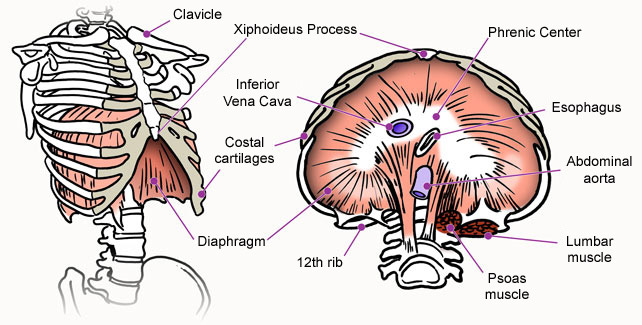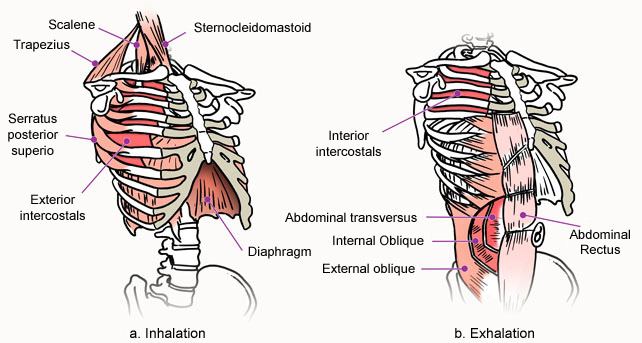Asclepius' Ampoule - Breathing (II)
By Laura Lucchino, instructor of physical education and Pilates
Very often when I ask my students to bring their attention to their breathing they seem puzzled. They are puzzled by what they feel in their bodies.
One can breathe through the belly. One can breathe through the chest. One can play with breathing in general. By controlling the airflow some exercises become much more intense.
The most common question I am asked is, "how is it that the air is moving underneath our hands if the lungs are the ones that are filling up and emptying out?"
Respiratory act's anatomy
In reality the lungs, made of a spongy tissue, expand when they fill up with air and contract with the exhalation. The funny thing is that the lung by itself does not have the ability to expand. It needs the help of a meticulous organization.
The breathing mechanism is very complex. It is a perfect organization made of two movements: inhalation and exhalation. Skeleton, muscles and bowels work in complete synergy. Many are the muscles that come into play during the respiratory activity.
The diaphragm is the main respiratory muscle. It divides the thoracic cavity from the abdominal one. It forms a dome whose inferior extremity is inserted into the internal edge of the thoracic cavity, more precisely at the 12th rib, into the inferior cartilages and into the xiphoideus process of the sternum. The pillars of the diaphragm are inserted into the lumbar vertebrae. It is made of muscular fibers for one part and of tendons: the phrenic center (fig.1).
The diaphragm is connected to the principal abdominal organs. Its role is crucial not only for respiration, but also for phonation, for deglutition and for the expelling phase. It supports the heart: its movement helps the blood flow towards it. Furthermore its proper functioning is essential for a correct posture.
All other muscles involved in respiration can be subdivided into two categories: inhaling and exhaling muscles.
During inhalation the thoracic cage expands by lifting the ribs. The sternum projects itself forward. The volume of the thorax increases allowing the expansion of the lungs. The diaphragm during inhalation contracts and lowers creating a pressure gap which lets the air in. Other muscles involved are intercostals muscles, Serratus posterior superior, Levator Scapulae, Scalene muscles and Trapezius superior (fig.2a).
During exhalation the diaphragm relaxes, the dome goes back up and the air is pushed out by the lungs. The Serratus posterior superior, Internal and External Obliques and the Trasversus Abdominis get activated to contract the volume of the thorax (fig.2b). Our most natural breathing occurs during sleep. Using accessories muscles we can force our respiration increasing the frequency or the depth of each breath.
Pilates
Since I became a Pilates instructor I have been always working on breathing. Pilates technique works all deep muscles, essential for a good posture. Many of the muscles that are important for a correct posture get activated by respiration. Thanks to the intuitions of J.H.Pilates instructors of this and other disciplines started working on awareness, on sensibility and on the links between breathing and movement.
Movement is vital to health. It improves life and wellbeing. A body gets stiff without movement. A respiratory system that works poorly gets stiff and slowly modifies our daily posture.
The body needs to be strong, dynamic and elastic. The respiratory system in order to function well has to respect the same principles. All muscles involved in this system have to be well balanced.
Exercises
There are plenty of exercises to improve our breathing awareness. I believe that many of these have to be executed with the help of an instructor who can provide the right tips. Some of them can be easy and fun. We can play with breathing, right? Let's try to become curious and have fun while exploring all the different things that happen while we breathe!
Exercise n. 1
From a supine position (facing up) place one hand on the belly and the other on the chest. Breathe trying to keep the air into the abdomen and feeling that only one hand at a time is moving: the one on the belly. When you are able to do this, try the opposite. Breathe keeping the belly still and moving only the chest. The next step will be to see what happens when you alternate one breath through the belly and one through the chest.

Exercise n. 2
Place your hands on the hips or on the back of your ribs to feel the movements of the body. It is interesting to feel the costal movements because they constantly change.
- bend forward letting neck and head fall towards the ground; place your hand on the back at the level of the last ribs and try to breathe deeply.
- breathe with your hands on the central ribs number 5, 6, 7, 8 and 9 and pay attention to their movement.
- breathe with your hands next to the clavicle to feel the movement of the ribs number 1, 2, 3 and 4.

Exercise n. 3
Change position, for example on your hands and knees or on your side, and breathe trying to maintain your belly soft.

Exercise n. 4
It can be fun to breathe plugging one nostril with one hand and with the other feel the right then the left hemithorax. It is quite curious to notice what happens in the thoracic cage.

Working on our breathing awareness can change our life. Athletic performances improve, our postural habits improve as well, spoiled by hours of sedentary life, and a bigger quantity of oxygen circulates throughout the organism, which becomes more efficient. Try, therefore, to spend a few minutes each day to breathe more consciously.
Illustrations

Fig. 1 - The diaphragm

Fig. 2 - Muscles involved during respiration